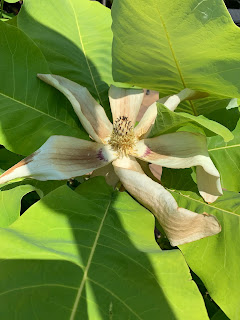These photos were taken by my mom this past May and June. I live in South Carolina and only visit every few months so I often miss out on the reward to some of my hard work, but these photos remind me why I love gardening so much. All of these are VERY low maintenance!
American Wisteria - blooms in May and June and again in July. Not as showy as Japanese Wisteria, but less invasive so definitely a win!
Hardy Ground Orchids (Bletilla striata) - These are unbelievably exotic looking, but perfectly hardy in a zone 7. They typically bloom in May, but the beautiful foliage will last all summer.
Baptisia (False Indigo) - makes a beautiful small shrub for the summer, but it's really special in May when it blooms! It comes in a few colors, but I love yellow!
Calycanthus floridus - is known as Carolina Allspice and is native to the US! The blooms are really exotic looking and fragrant! My particular plant isn't very fragrant, so make sure you sniff before you buy because some specimen are more spicy than others. These only bloom briefly in May, but the beautiful leaves stick around for the rest of the growing season.
Tradescantia virginiana (Virginia Spiderwort) is another native. These can get weedy, but the blooms are beautiful and they are beautiful if well kept. They only bloom in the spring. Very cold tolerant, compared to their houseplant relatives... purple heart, and wandering jew
Rhododendron need no introduction!
This rhododendron is known as Azalea "Garden Rainbow" and it blooms in early June. The blooms change color from yellow to reddish pink as they age. The result is a kaleidoscope of blooms in late May and early June. It's a deciduous azalea so expect just bare stems through the winter, but with a show like this in spring, it's worth the wait!
Clematis come in so many shapes and colors. They aren't tropical, but they sure look the part!
And honorable mention goes to these plants on my porch in South Carolina!
Queens Tears is definitely the most reliable bromeliad bloom I've ever grown. They bloom each winter, just when you're looking for color and they're cold hardy down into the 20s F. When they're not in bloom, the foliage is kind of blah, but when those inflorescences start to pop - WATCH OUT - they're stunning!
Where would we be without Camellias?
I don't understand why people don't grow pansies more often up north. They're cold-tolerant enough to bloom through mild winters in New York. Here in South Carolina, they're reliable in the landscape from October through May. That's 8 months out of the year, and they're at their best when it's chilly!
I am definitely a fan of weird geraniums. Vancouver Centennial probably isn't a huge fan of hot weather, but they can't get enough of spring.
That's all I have on cool weather until the Fall. Back to the beach!

















































